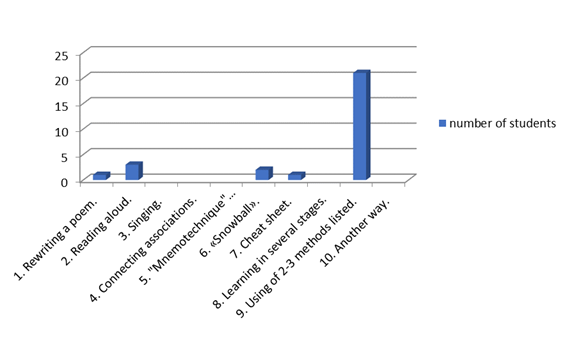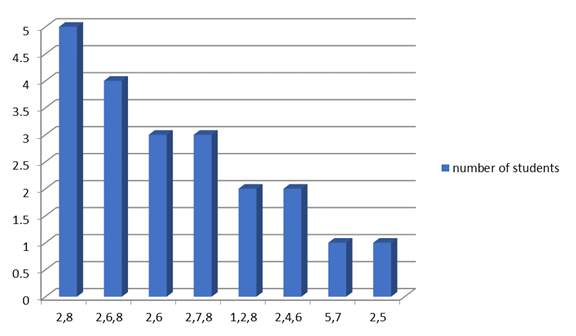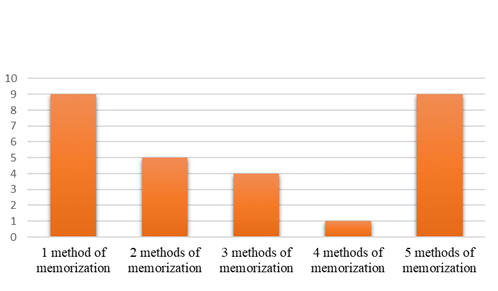Abstract
Memory is a complex mental process which has been studied by many scientists in different time periods. The results of some investigations allow now to conduct effective training on the development of memory, using non-traditional methods of processing and storing information. Therefore, it is necessary to pay special attention to ensure that the younger students learned how to memorize and reflect upon educational material and to inform students systematically with the techniques of memory management. It is very important in testing and correction of the child's memory to orient more on semantic memory and show a variety of techniques to help remember the material better. The purpose of the study was to carry out an experiment to identify the most effective way to memorize poems among primary school children, test several ways in practice and to analyze the results of the survey. It was found that the most effective way of memorization is the combination of methods, mainly reading aloud, using cheat sheet and several stages of learning, when several sensory organs (sight, hearing) and visual - imaginative thinking are involved at once.
Keywords: Memory, memory processes, ways of memorization, voluntary memorization, mechanical memorization
Introduction
Primary school teachers and English teachers do reach for poetry, because it is a perfect vehicle for teaching children about the workings of language and the workings of the world around them. Poetry is by nature meant to read aloud and, as such is a powerful tool, for building children’s phonemic awareness (their ability to pick out and manipulate the sounds in spoken words). Sharing the poems with students gives a possibility to play with the language – not only read the poems aloud, but also make up students’ own rhymes, point out examples of alliteration, word families, syllables, beginning and ending consonants, long and short vowels and other aspects of language up to literary elements. Poetry opens up children’s imagination and heart. So, the benefits of memorizing poetry are varied and deep and therefore it is not surprising that poem memorization is a standard assignment in many schools. However, as practice shows, at the initial stages of education in primary schools, this task may come easily only for some students, but for others it can be extremely difficult. Research has shown that memory works like a muscle: the more you exercise it, the better it functions. Memory strategies are a process in order to build easy, go-to techniques. Like any other skill, it takes practice and dedication. There is no way to magically develop memory, but if teachers alter students’ habits of thinking they can utilize the full potential of the memorization skills children already have. Everyone has different ways that the learn things the best, and finding the best way that students are able to memorize things is going to give them an edge on retaining all the necessary information that they need. The processes of memory are memorization, preservation, reproducing and forgetting. At the same time, the main one is the process of entering information - memorization. When solving the problem of optimizing the development of voluntary memorization in primary school children, the problem of overcoming mechanical memorization becomes particularly relevant.
Problem Statement
The main difficulty that a primary school student experiences when memorizing poems is that it is impossible to reproduce the approximate content of the poem, to retell it in his own words. Therefore, poems have to be memorized "word-for-word", often without understanding the meaning of new words and without a deep understanding of what they read. To comprehend means to be able to separate the main thing from the secondary, to be able to dissect and generalize the material, to think about it. It is not easy to do this without the guidance and advice of the elders. Therefore, many children try to "memorize" the material, that is, replace understanding with memorization. The disadvantage of cramming is also that it is a purely mechanical memorization, as a result of which the material is not stored in the brain. It is proved that meaningful memorization is many times more productive than mechanical memorization. Mechanical memorization is uneconomical and requires a lot of repetition. A person can’t always apply what he has learned mechanically to the place and time. It is meaningful memorization that contributes to the development of memory.
Comprehension of the material is achieved by a variety of methods that are not yet mastered by younger students and that they need to be taught. At the same time, it is advisable for the teacher to use special techniques and means of memorization, which will facilitate the process of memorization and also help to deeply comprehend the content of poetic works. In the course of our research, we found out that today there are various methods of memorizing poems, but, unfortunately, many of them are not used in modern schools.
Research Questions
In course of the study the following questions were raised:
- What techniques do young students use memorizing poems in Russian and English?
- What are they guided by when choosing a technique?
- Are these techniques common, universal for the entire class, or individual for each student?
- What techniques should they be taught to make the process of memorizing easier and more efficient in the future?
Purpose of the Study
Supposedly, the answers to the issues raised above will help achieve the goal and contribute to identifying the most effective way for young students to memorize poems. To achieve this goal, the following tasks were set:
1. When analyzing the literature, identify the most common methods of memorizing poems and make a questionnaire.
2. Using a questionnaire to explore ways to memorize in experimental group of children and to identify the number of students who have difficulties memorizing a poem.
3. To carry out an experiment on memorizing the Russian and English poems, test several ways of memorization in practice.
4. To analyze the results of the survey and experiment on the research topic.
Subject of the survey were different ways to memorize poems.
Objects of the survey were a poem from the textbook of literary reading (for the 2nd grade) "Hedgehog" in Russian and a poem «Colour Idioms Song» in the English language.
Research Methods
Authors used the universal scientific research methods as well as methods for comparative and statistical analysis.
Survey of the literature
Voluntary memorization in psychology is understood as indirect, step-by-step, based on special means (signs, symbols, schemes, etc.) (Istomina, 1975). Modern psychology has a rather large amount of research on the arbitrariness of memory in children. The development of memorization techniques by primary school children was also studied in the works of Belenkaya (2014), Zinchenko (2000), Karpova (2000), Raigorodsky (2000), Semenova and Sidorina, 2016, Smirnov (2008), Elkonin (2011), Kulinich (2009).
Questionnaires
The students were given questionnaires in order to determine the most used ways of learning in the class. A sample questionnaire is provided below (Table 1).
Experiment
For conducting an experiment in the classroom students were divided into 4 groups randomly (students chose cards with the group number) and each group was offered a method of memorization:
- group1– a combination of methods: Reading aloud, "Snowball", Learning in several stages,
- group 2 -a combination of methods: Readingaloud, Cheat Sheet, Learning in several stages,
- group3 -a combination of methods: Rewriting a poem, Reading aloud, Learning in several stages,
- group4 -a combination of methods: Readingaloud, Connecting associations, "Snowball".
As a result of the experiment (based on the poem in the Russian language), the most effective method of memorization was determined - a combination of methods in group 2 (Reading aloud, Cheat Sheet, Learning in several stages). Based on the material of poems in the English language, it was determined that students need more ways of memorization (up to 5 ways). And the leading ways of memorization were "Connecting associations" and "Snowball". The effectiveness criteria were the quality of reproduction and the speed of memorization of the poem.
Findings
The results of the survey were calculated and presented in Figure 1 which is demonstrating that only single students use the methods "Rewriting a poem" (1) and "Cheat Sheet" (1) while most of the students (21) have chosen 2-3 of the methods listed in the questionnaire".

Further review of the students’ answers reveals the following data shown on Figure 2 where the number of students is marked on the vertical axis and the chosen number of the point from the questionnaire is on the horizontal axis. The following combinations of methods were defined:
- Reading aloud, "Snowball", Learning in several stages (4 students)
- Reading aloud, Cheat Sheet, Learning in several stages (3 students)
- Rewriting a poem, Reading aloud, Learning in several stages (2 students)
- Reading aloud, Connecting associations, "Snowball" (2 students)
Combinations of two learning methods were also identified (10 students):
- Reading aloud, Learning in several stages (5 students)
- Reading aloud, "Snowball" (3 students)
- " Mnemotechnique" (Drawing), Cheat sheet (1 student)
- Reading aloud, "Mnemotechnique" (Drawing) (1 student)
It is noteworthy, that reading aloud and learning in several stages prevail in this survey. They seem to be the most working method of memorizing in the group, but this may be due to the lack of awareness of other techniques, lack of creative thinking and formal approach to homework. So, out of the total number of (28) students in the class, 7 students use one learning methods, 10 students use two methods, and the rest 11 students use three learning methods. It can be concluded that students in the class need a combination of several learning methods.

For a more in-depth study of methods of memorizing poems by primary school students, the children of the same class were given the English poem «Colour Idioms Song» in which a phraseological unit with a color component was used. Students were asked to learn the poem by heart in different ways from the above questionnaire. The descriptive statistics are presented in the Figure 3.

As a result, it turned out that either 1 method or a combination of 5 ways of memorization a poem by students prevail, 2 and 3 ways are chosen by the less number of students, 4 ways of memorization are rarely chosen by students. The methods «Connecting associations» and «Snowball» were the leading ones for the choice of memorization.
Conclusion
Thus, as a result of the study, the ways of memorization at students in the classroom were determined and the most effective way of memorization was established. Among the many methods of memorization, the most effective is the combination of methods - reading aloud, using сheat sheet and several stages of learning. At the same time, several sensory organs (sight, hearing) and visual-imaginative thinking are involved at once.
References
Belenkaya, T. B. (2014). Mnemonics for elementary school, training memory in younger students. Phoenix Publishing House.
Elkonin, D. B. (2011). Child psychology: a textbook for students of institutions of higher professional education. Academia.
Istomina, Z. M. (1975). The development of voluntary memory in preschool-age children. Soviet Psychology, 13(4), 5-64.
Karpova, E. V. (2000). Didactic games in the initial period of training. Popular manual “Academy of Development”, 112.
Kulinich, G. G. (2009). Subjects weeks and open English lessons: 2-4 grades. VAKO.
Raigorodsky, D. Ya. (2000). Practical psychodiagnostics. Methods and Tests: A textbook. Bahrach.
Semenova, E. A., & Sidorina, E. V. (2016). Features of the development of memorization in modern younger schoolchildren. Modern scientific research and innovation, 12. http://web.snauka.ru/issues/2016/12/76393
Smirnov, A. A. (2008). Arbitrary and involuntary memorization. Psychology of memory. (Edited by Yu. B. Gippenreiter & V. Ya. Romanov). CHERO.
Zinchenko, P. I. (2000). Involuntary memorization and activities. The Psychology of memory: a reader. Ed. Gippenreiter Yu. B., V. Ya. Novels. Chero, (pp. 465-476).
Copyright information

This work is licensed under a Creative Commons Attribution-NonCommercial-NoDerivatives 4.0 International License.
About this article
Publication Date
25 September 2021
Article Doi
eBook ISBN
978-1-80296-115-7
Publisher
European Publisher
Volume
116
Print ISBN (optional)
-
Edition Number
1st Edition
Pages
1-2895
Subjects
Economics, social trends, sustainability, modern society, behavioural sciences, education
Cite this article as:
Barsagayeva, S. V., Korbmakher, T. V., Grotskaya, N. N., & Urvantseva, A. K. (2021). Learning Methods Of Memorization Poems For Primary School Children. In I. V. Kovalev, A. A. Voroshilova, & A. S. Budagov (Eds.), Economic and Social Trends for Sustainability of Modern Society (ICEST-II 2021), vol 116. European Proceedings of Social and Behavioural Sciences (pp. 1381-1387). European Publisher. https://doi.org/10.15405/epsbs.2021.09.02.155

